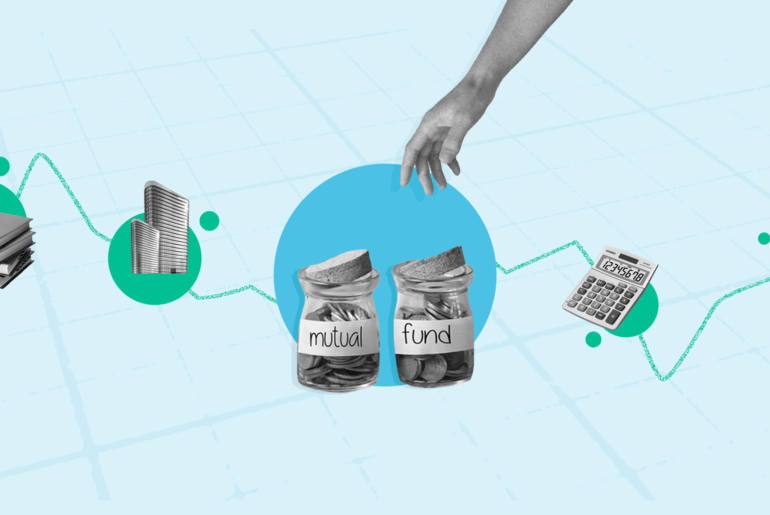Last Updated on Apr 29, 2025 by vanessa sequeira
The Indian stock market categorises listed companies based on their market capitalisation, which refers to the total monetary worth of a company. There are three categorisations of market cap – large cap, mid cap, and small cap. Also known as blue chip stocks, large cap stocks are shares issued by a company with over Rs 20,000 cr. Mutual funds primarily investing in such stocks are called large cap funds or blue chip mutual funds. In this blog, explore the list of the top 10 large cap mutual funds based on their 5-yr CAGR, the advantages and risks of investing in them and more.
Table of Contents
Top 10 Large Cap Mutual Funds In India
| Name | AUM (Cr) | CAGR 3Y (%) | Expense Ratio (%) | NAV | CAGR 5Y (%) | Volatility (%) |
| Nippon India Large Cap Fund | 37,546.38 | 21.10 | 0.71 | 94.88 | 28.35 | 15.63 |
| ICICI Pru Bluechip Fund | 64,962.52 | 18.55 | 0.89 | 115.25 | 26.16 | 14.38 |
| HDFC Large Cap Fund | 36,108.73 | 17.68 | 0.99 | 1187.03 | 25.34 | 15.58 |
| Kotak Bluechip Fund | 9,424.03 | 16.18 | 0.62 | 621.97 | 24.30 | 15.06 |
| Edelweiss Large Cap Fund | 1,156.58 | 17.07 | 0.61 | 92.05 | 24.13 | 15.25 |
| Aditya Birla SL Frontline Equity Fund | 28,105.70 | 15.96 | 1.02 | 553.86 | 24.08 | 14.74 |
| Invesco India Largecap Fund | 1,328.90 | 17.15 | 0.75 | 78.10 | 24.00 | 16.47 |
| DSP Top 100 Equity Fund | 5,070.17 | 20.42 | 0.97 | 503.81 | 23.90 | 13.77 |
| Tata Large Cap Fund | 2,452.63 | 15.50 | 1.04 | 549.73 | 23.85 | 15.99 |
| Mahindra Manulife Large Cap Fund | 610.68 | 15.60 | 0.68 | 24.92 | 23.81 | 14.80 |
Note: This data in the large cap mutual funds list is for educational purposes and is not recommendatory in nature. The data is as of 28th April 2025 and the parameters used to filter are as follows
Category: Equity Funds > Large Cap Fund
- AUM (Assets Under Management)
- 3-yr CAGR
- 5-yr CAGR – set from high to low
- NAV (Net Asset Value)
- Volatility
Overview of the Best Large-Cap Mutual Funds In India
Nippon India Large Cap Fund
Nippon India Large Cap Fund primarily aims to generate long-term capital appreciation by investing predominantly in equity and equity-related instruments of large-cap companies. Among the top large-cap mutual funds, it also seeks to deliver consistent returns by investing in debt, money market securities, REITs, and InvITs.
ICICI Prudential Bluechip Fund
ICICI Prudential Bluechip Fund endeavours to generate long-term capital appreciation and income distribution. Among the large-cap funds with high returns, it primarily invests in equity and equity-related securities of large-cap companies.
HDFC Large Cap Fund
HDFC Large Cap Fund seeks to provide long-term capital appreciation and income by predominantly investing in equity and equity-related instruments of large-cap companies.
Kotak Bluechip Fund
Kotak Bluechip Fund aims to generate capital appreciation by investing mainly in equity and equity-related securities of companies classified as large-cap.
Edelweiss Large Cap Fund
Among the best large-cap mutual funds, Edelweiss Large Cap Fund targets long-term capital appreciation through investments predominantly in equity and equity-related securities of the 100 largest companies by market capitalisation listed in India.
What Is A Large Cap Stock?
Large cap stocks belong to NIFTY 100. It comprises companies that are leaders in their sectors and are perceived to be less risky. Moreover, large cap stocks are touted to be the most stable stocks as they are of established and reputable companies. Therefore, investors who want to approach a less risky route to wealth creation invest in large cap stocks as they are known for their stability in the market.
What Are Large Cap Mutual Funds?
Simply put, large cap mutual funds are equity funds that invest in the top 100 stocks of India based on their market capitalisation. These stocks are primarily leaders across market sectors and are also known as blue chip mutual funds. They are less risky than mid and small cap funds as market movements do not heavily impact them. These are stable and generate consistent returns compared to mid and small cap funds.
Features Of Large Cap Mutual Funds
The features of large-cap equity funds include:
- Stability and Reliability: Large-cap companies tend to have more stable financial histories and consistent performance.
- Diversification: These funds offer diversification by investing in multiple large-cap stocks across various sectors.
- Liquidity: Large-cap stocks are highly liquid, making it easier to buy and sell units in these funds.
- Lower Volatility: The best large-cap mutual funds for SIP experience lower price volatility compared to small- or mid-cap funds, making them a safer option in uncertain market conditions.
Advantages Of Investing In Large-Cap Mutual Funds 2025
Investing in large-cap funds comes with several advantages, especially for risk-averse investors:
- Stability: Large-cap companies tend to withstand economic downturns better than smaller firms. As a result, large-cap mutual funds are relatively less risky.
- Steady Growth: While large-cap companies may not experience explosive growth like smaller companies, they usually offer steady and reliable returns.
- Regular Dividends: Many large-cap equity mutual funds pay dividends regularly, providing investors with an additional source of income.
- Professional Management: These funds are managed by experienced professionals who make investment decisions based on thorough research and analysis.
Who Should Explore Large Cap Mutual Funds?
Large-cap mutual funds for growth are ideal for investors who:
- Seek Stability: Investors who prefer lower risk and more stability in their portfolios.
- Long-Term Goals: As large-cap funds for long-term generally provide steady returns over time, hence they are preferable for those with long-term investment horizons,
- Conservative Investors: Conservative investors who are risk-averse and seek safety in their investments would benefit from large-cap equity funds.
- New Investors: Beginners who are new to investing can also consider large-cap mutual large-cap equity funds due to their relative stability and well-diversified nature.
Risks Associated With Investing In Large Cap Mutual Funds
Though large-cap fund options are considered less risky han smaller-cap funds, they do carry some risks:
- Market Risk: Even the best bluechip mutual funds are still susceptible to market fluctuations, and while less volatile, they are not immune to economic downturns.
- Limited Growth Potential: As large companies are already well-established, their growth potential is lower compared to smaller companies. This could lead to slower capital appreciation.
- Underperformance in Bull Markets: During periods of market boom, even high-potential large-cap funds might underperform compared to small- or mid-cap funds that benefit more from rapid growth.
Factors To Consider Before Investing In Large Cap Mutual Funds
Before investing in large-cap mutual funds, consider the following factors:
- Fund’s Track Record: Review the performance history of high-return large-cap funds, including its fundamentals, to evaluate how it has fared in various market conditions.
- Expense Ratio: Consider the cost of investing in a particular fund. A lower expense ratio can lead to better returns in the long run.
- Fund Manager’s Expertise: The experience and track record of the fund manager can play a crucial role in the performance of large-cap growth funds.
- Investment Objectives: Ensure that the fund’s objectives align with your financial goals, whether they are long-term growth, income generation, or capital preservation.
- Diversification: Check if the fund provides adequate diversification to reduce risk and enhance potential returns.
Taxation Of Large Cap Funds
The taxation on large cap funds is as follows:
– Short-Term Capital Gains (STCG): The mutual funds held for less than a year are known as STCG. These gains are taxed at 20%.
– Long-Term Capital Gains (LTCG): The mutual funds held for over a year are known as LTCG. If the gains are below Rs. 1.25 lakh, they are tax-free. If the gains are above Rs. 1.25 lakh, the gains will be taxed at 12.5% without any indexation benefit.
| Capital Gains Tax | Holding Period | Old Rate | New Rate |
| Short-Term Capital Gains (STCG) | Less than 12 months | 15% | 20% |
| Long-Term Capital Gains (LTCG) | More than 12 months | 10% | 12.50% |
How to choose a large cap fund for your financial goal?
Consider the following factors when choosing the large cap fund suitable for your financial goal:
– Ensure the fund’s objective matches your investment needs and goals, such as diversification of investment across different sectors or consistent returns YoY.
– Look at the historical mutual fund returns. While past performance is no guarantee for future returns, analysing a fund’s historical returns across bull and bear cycles gives meaningful insights into the fund’s performance.
– Compare the mutual fund returns with that of the category average to identify underperforming or overperforming schemes
– Read about the fund manager and their qualification and experience. Analyse their past performance across various market cycles.
– Compare the fund’s expense ratio with that of the peers. The lower the expense ratio, the higher the returns. However, investing in a fund with a low expense ratio while not analysing other important factors can harm your returns.
Wrap It Up
Large-cap mutual funds are an excellent investment option for individuals seeking a balance between stability and growth. With their reliable returns, lower volatility, and professional management, they are suitable for both conservative investors and those planning for the long term. However, like any investment, large-cap funds come with their risks, and it’s important to carefully consider factors such as the fund’s track record, expense ratio, and alignment with your financial goals before investing. Keep an eye on best large-cap mutual funds India and large-cap mutual fund performance to make informed choices that suit your financial strategy.
Frequently asked questions (FAQs)
Do large cap funds pay dividends?
Yes, since large cap funds invest in equity, they offer a dividend payout plan. Be sure to check with your distributor or the Asset Management Company’s website for such variants.
How do large-cap mutual funds perform during market corrections?
During market corrections, large-cap mutual funds tend to be more resilient compared to mid- and small-cap funds. While they may still experience a drop in value, the impact is often less severe, as large-cap companies usually have established market positions and financial stability.
Are large-cap mutual funds good for short-term investment goals?
Large-cap mutual funds are typically more suited for long-term investment goals. While they offer stability, their growth potential is moderate compared to smaller companies.
- Best Performing Index Funds in India (2025) - Jun 5, 2025
- Issue of Shares – Meaning, Types, Examples and Steps - Jun 4, 2025
- Banking Mergers in India – List of Merged PSU Banks, Advantages, and Challenges - Jun 3, 2025





